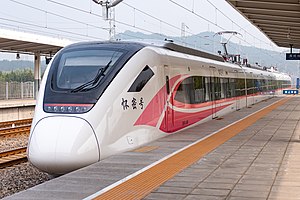| BCR | |||
|---|---|---|---|
 | |||
| Overview | |||
| Locale | Beijing | ||
| Transit type | Commuter rail | ||
| Number of lines | 4 | ||
| Number of stations | 25 | ||
| Operation | |||
| Began operation | August 6, 2008 | ||
| Operator(s) | China Railway Beijing Group | ||
| Technical | |||
| System length | 400 km (250 mi) | ||
| Track gauge | 1,435 mm (4 ft 8+1⁄2 in) | ||
| |||
| BCR | |||||||
|---|---|---|---|---|---|---|---|
| Simplified Chinese | 北京城市铁路 | ||||||
| Traditional Chinese | 北京城市鐵路 | ||||||
| |||||||
| Alternative Chinese name | |||||||
| Simplified Chinese | 北京市郊铁路 | ||||||
| Traditional Chinese | 北京市郊鐵路 | ||||||
| |||||||



BCR (Beijing City Rail) also known as Beijing Suburban Railway is a commuter rail service that connects urban Beijing with outlying districts beyond the reach of the city's Beijing Subway network. The suburban rail services run on existing China Railway lines.
Contents
The suburban rail services are managed by the China Railway Beijing Group,an agency of the Ministry of Railways that is not affiliated with the operators of Beijing Subway.
There are 4 suburban railway corridors currently in operation:Line S2,Sub-Central line,Huairou–Miyun line and Tongmi line.

